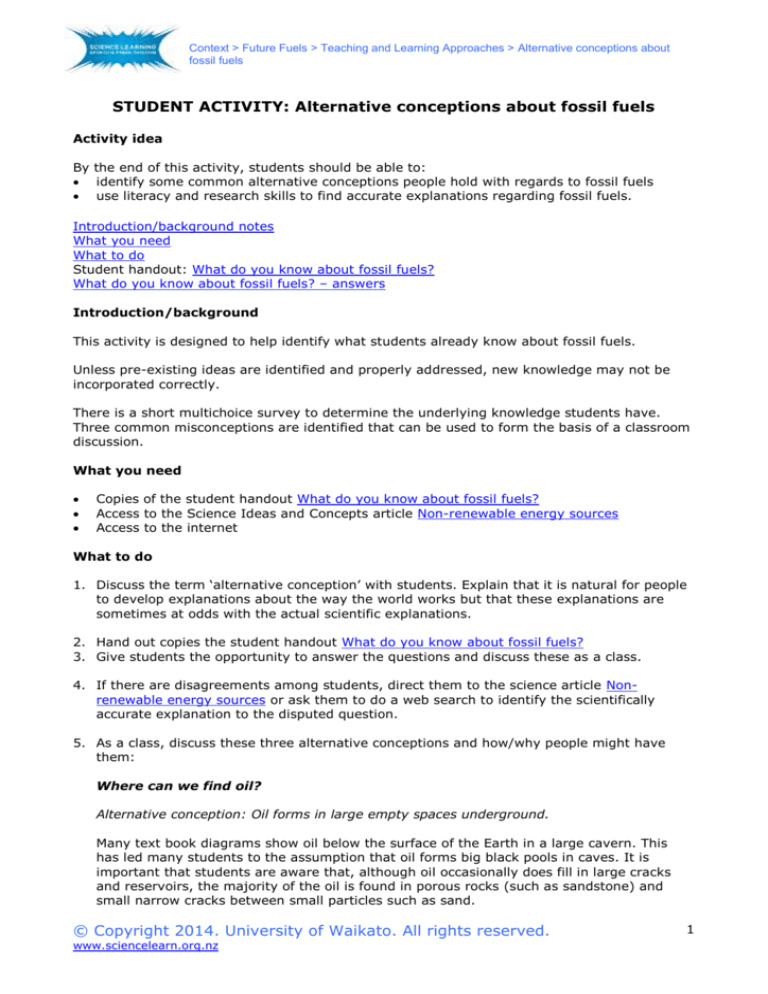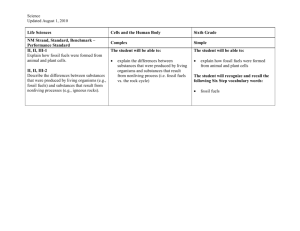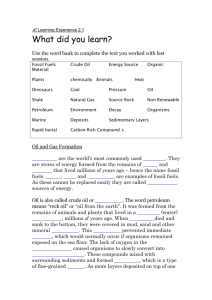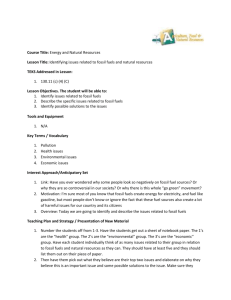
Context > Future Fuels > Teaching and Learning Approaches > Alternative conceptions about
fossil fuels
STUDENT ACTIVITY: Alternative conceptions about fossil fuels
Activity idea
By the end of this activity, students should be able to:
identify some common alternative conceptions people hold with regards to fossil fuels
use literacy and research skills to find accurate explanations regarding fossil fuels.
Introduction/background notes
What you need
What to do
Student handout: What do you know about fossil fuels?
What do you know about fossil fuels? – answers
Introduction/background
This activity is designed to help identify what students already know about fossil fuels.
Unless pre-existing ideas are identified and properly addressed, new knowledge may not be
incorporated correctly.
There is a short multichoice survey to determine the underlying knowledge students have.
Three common misconceptions are identified that can be used to form the basis of a classroom
discussion.
What you need
Copies of the student handout What do you know about fossil fuels?
Access to the Science Ideas and Concepts article Non-renewable energy sources
Access to the internet
What to do
1. Discuss the term ‘alternative conception’ with students. Explain that it is natural for people
to develop explanations about the way the world works but that these explanations are
sometimes at odds with the actual scientific explanations.
2. Hand out copies the student handout What do you know about fossil fuels?
3. Give students the opportunity to answer the questions and discuss these as a class.
4. If there are disagreements among students, direct them to the science article Nonrenewable energy sources or ask them to do a web search to identify the scientifically
accurate explanation to the disputed question.
5. As a class, discuss these three alternative conceptions and how/why people might have
them:
Where can we find oil?
Alternative conception: Oil forms in large empty spaces underground.
Many text book diagrams show oil below the surface of the Earth in a large cavern. This
has led many students to the assumption that oil forms big black pools in caves. It is
important that students are aware that, although oil occasionally does fill in large cracks
and reservoirs, the majority of the oil is found in porous rocks (such as sandstone) and
small narrow cracks between small particles such as sand.
© Copyright 2014. University of Waikato. All rights reserved.
www.sciencelearn.org.nz
1
Context > Future Fuels > Teaching and Learning Approaches > Alternative conceptions about
fossil fuels
What is oil made from?
Alternative conception: Oil comes from dead dinosaurs.
While many students understand that hydrocarbons are the result of decaying organisms,
they often lack the understanding of the actual material of origin. For oil, predominantly it
is the result of decaying marine organisms that were buried beneath ocean sediment. Coal
is the result of decaying swamp vegetation. The idea of dinosaurs may be linked to the use
of them in cartoons to illustrate the formation of fossil fuels. There is a further problem
with some students thinking fossil fuels have always been present in the Earth. This idea
may stem from the idea that oil and coal take a long time to form. Alternatively, students
may think oil and coal are made in much shorter time periods (hundreds, instead of
millions of years).
Where can oil be found?
Alternative conception: Oil won’t be found under the ocean/desert/forest.
This idea originates from two sources. The first is a lack of understanding regarding the
origin of oil and coal (that it is from fossilised marine or swamp matter). The second is the
belief that the Earth surface is static – that it looks the same now as it did millions of years
ago. Without the understanding of continental drift and climate change, it is difficult to
imagine that what is now a desert could have once been an ocean.
© Copyright 2014. University of Waikato. All rights reserved.
www.sciencelearn.org.nz
2
Context > Future Fuels > Teaching and Learning Approaches > Alternative conceptions about
fossil fuels
Student handout: What do you know about fossil fuels?
(This survey is adapted from Elementary Students’ Ideas Concerning Fossil Fuel Energy by
Audrey Rule.)
1. What are petroleum products used for? (Circle all that apply.)
a) Lubricating motor vehicles
b) Cooking oil
c) Making plastics
d) Fuel for the car
e) I don’t know
2. Where does petroleum come from?
a) Dead dinosaurs
b) Ancient plankton and sealife
c) It’s always been part of the Earth
d) People make it
e) I don’t know
3. Underground, the oil (petroleum) looks like...
a) A large cave filled with oil
b) A river of black oil flowing through a tunnel
c) A solid black layer of carbon
d) Liquid metal moving slowly
e) Drops of oil mixed with sand or filling small cracks
f) I don’t know
4. Where is oil not found? (Circle all that apply.)
a) Under the ocean
b) Under the desert
c) Under very cold landscapes
d) Under forests
e) None of the above
f) I don’t know
5. How long does oil take to form?
a) It has always been part of the Earth
b) Millions of years
c) Thousands of years
d) Hundreds of years
e) Less than 100 years
f) People can make it from other products
g) I don’t know
6. What role does oil play in global problems? (Circle all that apply.)
a) Contaminating the environment from oil spills
b) Wars between different countries
c) Air pollution
d) Global warming
e) No significant role
f) I don’t know
© Copyright 2014. University of Waikato. All rights reserved.
www.sciencelearn.org.nz
3
Context > Future Fuels > Teaching and Learning Approaches > Alternative conceptions about
fossil fuels
What do you know about fossil fuels? – answers
Scientifically consistent answers:
1. A, C, D
2. B
3. E
4. E
5. B
6. A, B, C, D
© Copyright 2014. University of Waikato. All rights reserved.
www.sciencelearn.org.nz
4









